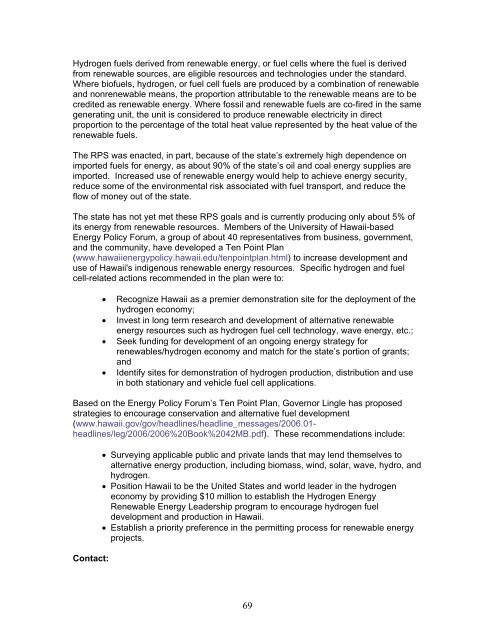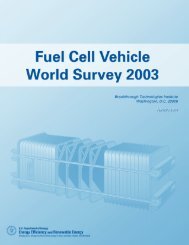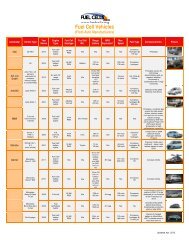Breakthrough Technologies Institute - Fuel Cells 2000
Breakthrough Technologies Institute - Fuel Cells 2000
Breakthrough Technologies Institute - Fuel Cells 2000
Create successful ePaper yourself
Turn your PDF publications into a flip-book with our unique Google optimized e-Paper software.
Hydrogen fuels derived from renewable energy, or fuel cells where the fuel is derived<br />
from renewable sources, are eligible resources and technologies under the standard.<br />
Where biofuels, hydrogen, or fuel cell fuels are produced by a combination of renewable<br />
and nonrenewable means, the proportion attributable to the renewable means are to be<br />
credited as renewable energy. Where fossil and renewable fuels are co-fired in the same<br />
generating unit, the unit is considered to produce renewable electricity in direct<br />
proportion to the percentage of the total heat value represented by the heat value of the<br />
renewable fuels.<br />
The RPS was enacted, in part, because of the state’s extremely high dependence on<br />
imported fuels for energy, as about 90% of the state’s oil and coal energy supplies are<br />
imported. Increased use of renewable energy would help to achieve energy security,<br />
reduce some of the environmental risk associated with fuel transport, and reduce the<br />
flow of money out of the state.<br />
The state has not yet met these RPS goals and is currently producing only about 5% of<br />
its energy from renewable resources. Members of the University of Hawaii-based<br />
Energy Policy Forum, a group of about 40 representatives from business, government,<br />
and the community, have developed a Ten Point Plan<br />
(www.hawaiienergypolicy.hawaii.edu/tenpointplan.html) to increase development and<br />
use of Hawaii's indigenous renewable energy resources. Specific hydrogen and fuel<br />
cell-related actions recommended in the plan were to:<br />
• Recognize Hawaii as a premier demonstration site for the deployment of the<br />
hydrogen economy;<br />
• Invest in long term research and development of alternative renewable<br />
energy resources such as hydrogen fuel cell technology, wave energy, etc.;<br />
• Seek funding for development of an ongoing energy strategy for<br />
renewables/hydrogen economy and match for the state’s portion of grants;<br />
and<br />
• Identify sites for demonstration of hydrogen production, distribution and use<br />
in both stationary and vehicle fuel cell applications.<br />
Based on the Energy Policy Forum’s Ten Point Plan, Governor Lingle has proposed<br />
strategies to encourage conservation and alternative fuel development<br />
(www.hawaii.gov/gov/headlines/headline_messages/2006.01headlines/leg/2006/2006%20Book%2042MB.pdf).<br />
These recommendations include:<br />
Contact:<br />
• Surveying applicable public and private lands that may lend themselves to<br />
alternative energy production, including biomass, wind, solar, wave, hydro, and<br />
hydrogen.<br />
• Position Hawaii to be the United States and world leader in the hydrogen<br />
economy by providing $10 million to establish the Hydrogen Energy<br />
Renewable Energy Leadership program to encourage hydrogen fuel<br />
development and production in Hawaii.<br />
• Establish a priority preference in the permitting process for renewable energy<br />
projects.<br />
69






